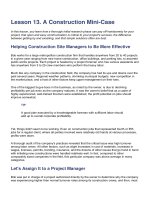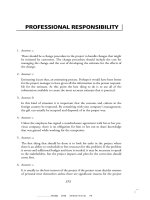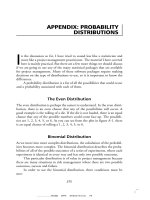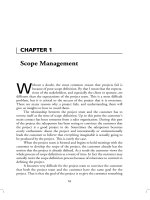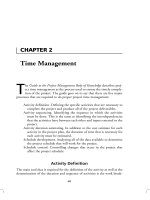Project management harold kerzner
Bạn đang xem bản rút gọn của tài liệu. Xem và tải ngay bản đầy đủ của tài liệu tại đây (6.19 MB, 307 trang )
Project Management a System
approach to Planning
Scheduling &
Controlling
- Harold Kerzner
Chapter
Introduction to Project
Management
History of Project Management
One of the first examples of project
management was the construction of the
pyramids in Egypt
Henry L. Gantt (1861-1919) added an important
visualization tool around 1917 with the Gantt
Chart
In the late 1950s, DuPont Company developed
the Critical Path Method (CPM)
Also in the late 1950s, Booz Allen Hamilton
developed the Program Evaluation and Review
Technique (PERT), which models uncertainty in
project management
3
Importance of Project Management
Project management effectively controls
organizational change, allowing
organizations to introduce new products,
new processes, and new programs
effectively.
Projects are becoming more complex,
making them more difficult to control
without a formal management structure.
Projects with substantially different
characteristics, especially in IT, are
emerging.
Project management helps cross-functional
teams to become more effective.
4
Comment on the Importance of
Project Management
“At last we are beginning to see
research which proves how important
project management is ... without welltrained and capable project managers
the percentage of GDP spent through
projects is inflated due to many
exceeding their budget through poor
management.”
Richard Pharro, author and consultant (2003)
Still, many organizations underappreciate the
5
contributions made by their project managers.
What is a Project?
A project is a “temporary endeavor
undertaken to create a unique product
or service”. (PMBOK, 2000)
A project is a well-defined set of tasks
or activities that must all be
completed in order to meet the
project’s goals. Two prevalent
characteristics:
Each task may be started or stopped
independently of other tasks;
Tasks are ordered such that they must be
performed in a technological sequence.
6
Examples of Projects
Construction of the pyramids
Apollo moon landing mission
Development of MS Windows
Making The Lord of the Rings
Organizing the Olympics Games
Development and marketing of a new drug
Implementing a new company wide IT
system
Design of this course
Project management spans both the
manufacturing and service sectors.
7
Manufacturing Perspective
Flowshop: The same sequence of
operations is used to create each
product or service.
Job Shop: A product or service only
flows through centers which are
required to create it.
8
Characteristics of Flowshop, Job Shop
and Project
Flowshop Job Shop Project
Product
Mass
Custom
Labor
Low skill
High skill High skill
Capital
High
Medium
Low
Variable
Highly
variable
Performance Good
(time, cost,
quality)
Unique
9
Project Management versus Process
Management
“Ultimately, the parallels between
process and project management give
way to a fundamental difference:
process management seeks to eliminate
variability whereas project management
must accept variability because each
project is unique.”
J. Elton, J. Roe. 1998. Bringing Discipline to
Project Management. Harvard Business Review.
See coursepack article: Oltra, Maroto and Segura
10
“Lean” Principles in Project Management
Focusing on customer needs
Balancing work to ensure an even flow
Using “customer pull” rather than
“supplier push” to initiate work
Using principles of continuous
improvement
See coursepack article: Brown et al.
11
Measures of Project Success
Overall perception
Cost
Completion time
Technical goals, compared to initial
specifications
Technical goals, compared to other
projects in the organization
Technical goals, taking into account
the problems that arose in the project
R.J. Might and W.A. Fischer (1985)
Question: Was the movie Titanic successful?
See coursepack article: The Chaos Report
12
Nine Factors Critical to
the Success of Many Projects
Clearly defined goals
Competent project manager
Top management support
Competent project team members
Sufficient resource allocation
Adequate communication channels
Effective control mechanisms
Use of feedback for improvement
Responsiveness to clients
J. Pinto and D. Slevin (1987)
See coursepack article: Czuchry and Yasin
13
Famous Project Failures
In 1988, Westpac Banking Corporation initiated a 5year, $85m project to improve its information system.
Three years later, after spending $150m with nothing
to show for it, they cancelled the project and
eliminated 500 development jobs.
The computerized baggage handling system at the
Denver International Airport delayed the opening of
the airport from March 1994 to February 1995 and
added $85 million to the original budget. The baggage
system continued to unload bags even though they
were jammed on the conveyor belt. The system also
loaded bags into telecarts that were already full.
Hence, some bags fell onto the tracks, causing the
telecarts to jam. The timing between the conveyor
belts and the moving telecarts was not properly
synchronized, causing bags to fall between the
conveyor belt and the telecarts. Then the bags became
wedged under the telecarts, which were bumping into
each other near the load point.
14
Famous Project Failures (cont.)
Disney's shipbuilder was six months late in
delivering its new cruise ships in 1998. Thousands
of Disney customers who had purchased tickets
had to be compensated for making different plans.
In 1997-99, Universal Studios in Orlando, Florida,
built a new restaurant and entertainment complex,
a two year project. The opening was delayed by
three months.
The “Big Dig” road construction project in Boston
(1987-2007) was budgeted at $5.8b but cost over
$15b. The project resulted in criminal arrests,
thousands of water leaks, death of a motorist from
a tunnel collapse, and hundreds of millions of
dollars in lawsuits.
In 2005, UK grocery chain J. Sainsbury wrote off its
15
$526m investment in an automated supply chain
Reasons why Projects Fail
Improper focus of the project management
system, e.g. on low level details
Fixation on first budget estimates
Too much reliance on inaccurate project
management software
Too many people on the project team
Poor communication within the project
team
Incentives that reward the wrong actions
See coursepack article: Mulder
16
Common Excuses for Project Failures
Unexpectedly poor weather delayed
construction
Unforeseeable poor performance by
contractors
Senior management imposed an
unrealistic schedule
Instructions by senior management
were unclear
Many wasteful “synchronization”
meetings interrupted actual work
See coursepack article: Pinto and Kharbanda
17
Management of IT Projects
More than $250 billion is spent in the
US each year on approximately
175,000 information technology
projects.
IT project management is an $850
million industry and is expected to
grow by as much as 20 percent per
year.
Gene Bounds, “The Last Word on Project
Management”, IIE Solutions, 1998.
18
IT Projects are Different
“[in IT projects], if you ask people
what’s done and what remains to be
done there is nothing to see. In an IT
project, you go from zero to 100
percent in the last second--unlike
building a brick wall where you can
see when you’re halfwayJ. done.”
Vowler (2001)
Engineering projects are measured by tasks completed
Example: building construction
IT projects are measured by resources used
Example: software development
19
IT Project Outcomes
Standish Group Survey, 1999.
(from a survey of 8000 business
systems projects)
20
Why do IT Projects Fail?
Ill-defined or changing requirements
Poor project planning/management
Uncontrolled quality problems, e.g.
software fails to complete computing
task in time
Unrealistic expectations/inaccurate
estimates
Adoption of new technology without
fully understanding it
Construx Software Builders, Inc., 2005.
Why are IT projects more difficult?
21
Wheelwright and Clark’s Classification
of Projects
22
Project Life Cycle
23
DESIGN
Design (Scope), Cost, Time Tradeoffs
Required
Performance
Target
M
TI
E
DU
E
CH
S
(
Due Date
)
E
L
Budget
Constraint
COST
Optimal Time-Cost
Tradeoff
“You can have your job done cheap, quick, or
right; pick two.” [Sign in local copy center.]
24
Project Management Maturity Model
(PMMM)
PMMM is a formal tool that can be
used to measure an organization's
project management maturity.
Once the initial level of maturity and
areas for improvement are identified,
the PMMM outlines the steps to take
toward project management
excellence
PMMM is based on extensive empirical
research that defines a “best practice”
database, as well as a plan for
improving the project management
process
25


